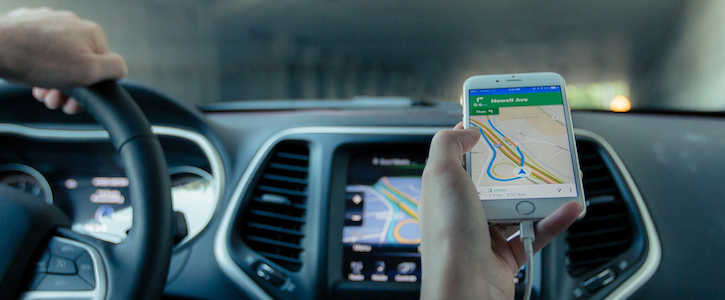A Free Ride With Lyft Didn't Reduce Skipped Medical Appointments
Researchers thought the tech-driven experiment could get Medicaid patients to the doctor. Why didn’t it work?

Transportation problems routinely stymie people when it comes to keeping medical appointments. According to a 2006 study, 3.6 million people miss doctor visits every year because they have trouble getting to the clinic or office. But does removing some transportation barriers enable patients to keep their appointments? Researchers from the Perelman School of Medicine at the University of Pennsylvania recently conducted a study to learn just that.
The researchers looked at 786 low-income patients in West Philadelphia who were Medicaid recipients and received medical care at 1 of 2 Penn Medicine practices. Roughly half were enrolled in the intervention arm of the study, in which they received an offer, during an appointment-reminder phone call, for a ride with the ridesharing company Lyft. The other half were in the control arm and received no free-ride offer during their reminder phone call. Despite the freebie, there was virtually no difference between the proportion of missed appointments in the intervention arm (36.5%) and in the control arm (36.7%), according to the findings.
Additionally, few of those in the intervention arm took advantage of the free rides: Just 85 of 288 who actually answered the phone calls during which the rides were offered ended up using them.
On the face of it, ridesharing services such as Uber and Lyft seem to be the answer to the problems that Medicaid patients frequently encounter when using nonemergency medical transportation (NEMT), a Medicaid benefit. NEMT often relies on local taxis to ferry residents to and from the doctor, and this may require users to sign up for the rides far in advance and endure lengthy waits for the taxis.
Taxis may not be tracked, so it’s impossible for Medicaid to confirm that drivers are prompt and knowledgeable about appointment locations. In contrast, platforms like Uber and Lyft allow for immediate scheduling and offer real-time tracking ability. Still, the Lyft offer didn’t translate to all patients in this study showing up for their appointments.
“It just wasn’t as much of a slam dunk as we’d all hoped at the end of the day,” Krisda H. Chaiyachati, MD, MPH, MSHP, a Veterans Affairs advanced fellow at the University of Pennsylvania’s medical school, an associate fellow at the Leonard Davis Institute of Health Economics at the University of Pennsylvania, and the study’s lead author, told Healthcare Analytics News™.
In fact, the rate of missed appointments in the study mirrored the rate of missed appointments nationwide among Medicaid patients, which can run anywhere from 35% to 50%, Chaiyachati said.
Why would a Medicaid patient not make it to a medical appointment despite being offered a free Lyft ride?
According to Chaiyachati, whose team interviewed roughly 45 patients who declined the rides, some people simply like the familiarity of their regular mode of transportation—whether that’s public transit or NEMT—and are loath to change. He also said free things may be undervalued; for some people, paying even a little bit for a service or good is preferable to accepting something for nothing. Finally, many Medicaid appointments are for the management of chronic conditions and not acute care. If a patient knows that the visit will involve talking about weight loss or the adjustment of a medication, they may feel it’s OK to skip the doc from time to time.
Many Medicaid patients have competing responsibilities, such as underage children, older relatives, and jobs that don’t allow them much in the way of flexibility. So when it comes to medical checkups, “these kinds of things can be pushed down the line,” Chaiyachati said.
One caveat about drawing conclusions from this study is that the team did not ask whether those who turned down the free Lyft rides ended up getting to their appointments via alternative mode of transportation, such as one offered by NEMT.
The goal now is to figure out which subset of the Medicaid population will benefit most from new transportation options and which subset will benefit most from other innovations, such as having physicians make house calls.
Clearly, the problem of missed appointments among Medicaid patients is about more than just being able to get to a clinic. What are the inhibiting factors that prevent them from being fully engaged with their providers? “To try to unpackage that will be an important task going forward,” Chaiyachati noted.
The study was recently published in JAMA Internal Medicine.
Related
Rise of the Anti-Opioid Algorithm
Why Healthcare Companies Shouldn't Shy Away from Tech Partnerships
Podcast: Match Made in Hospitals — Patient-Matching Technology Can Improve Healthcare
September 21st 2021Clay Ritchey, CEO of Verato, highlights the administrative and financial benefits that patient-matching technology can provide hospitals and health systems, as well as how it can improve the patient experience.
Podcast: Using Digital Solutions to Address Technology Shortfalls with Citius Tech Senior VPs
July 29th 2021In an interview recorded earlier this year, Chief Healthcare Executive Associate Editorial Director Mary Caffrey spoke with 2 leaders of Citius Tech about meeting healthcare challenges with digital solutions.